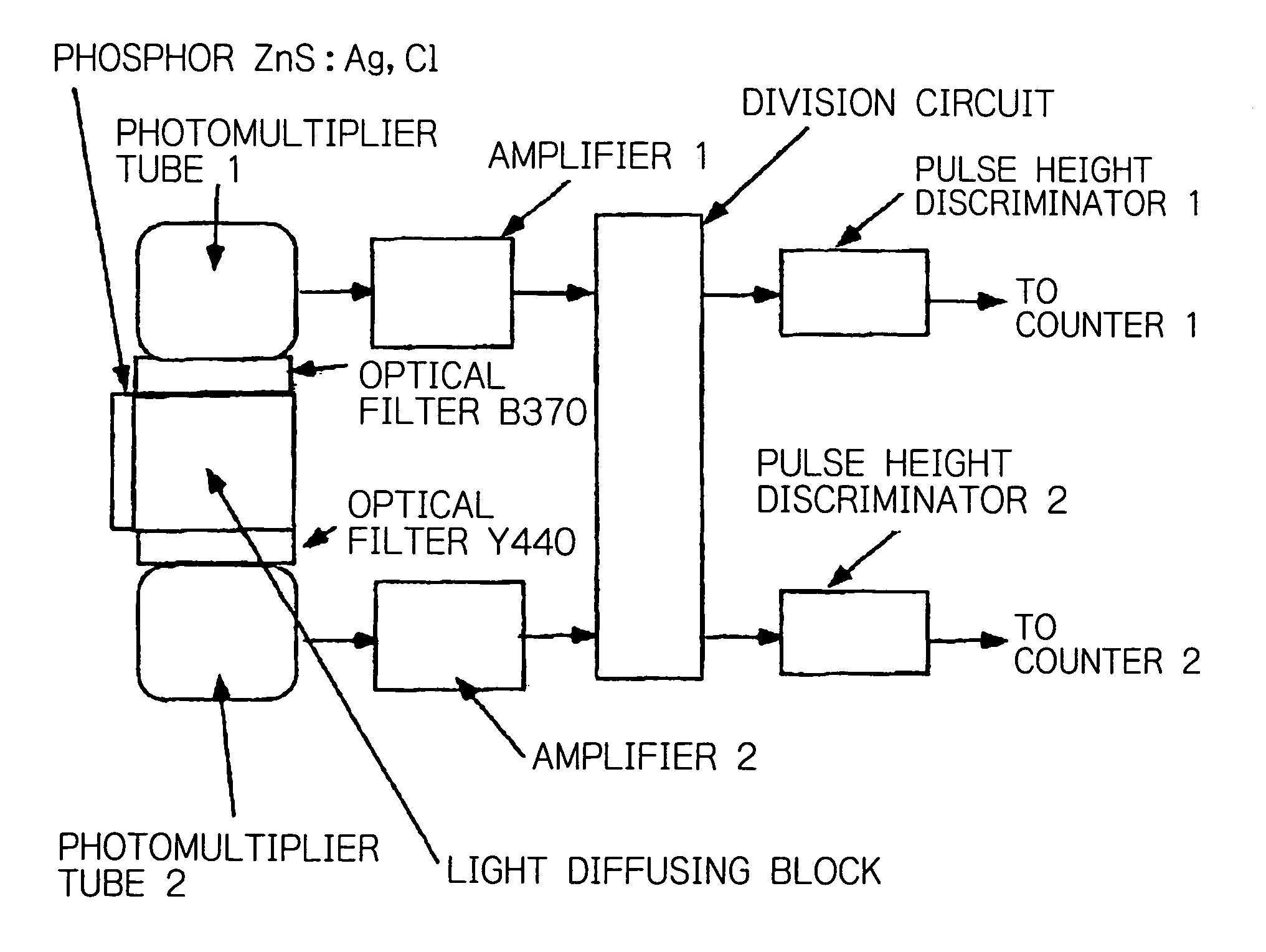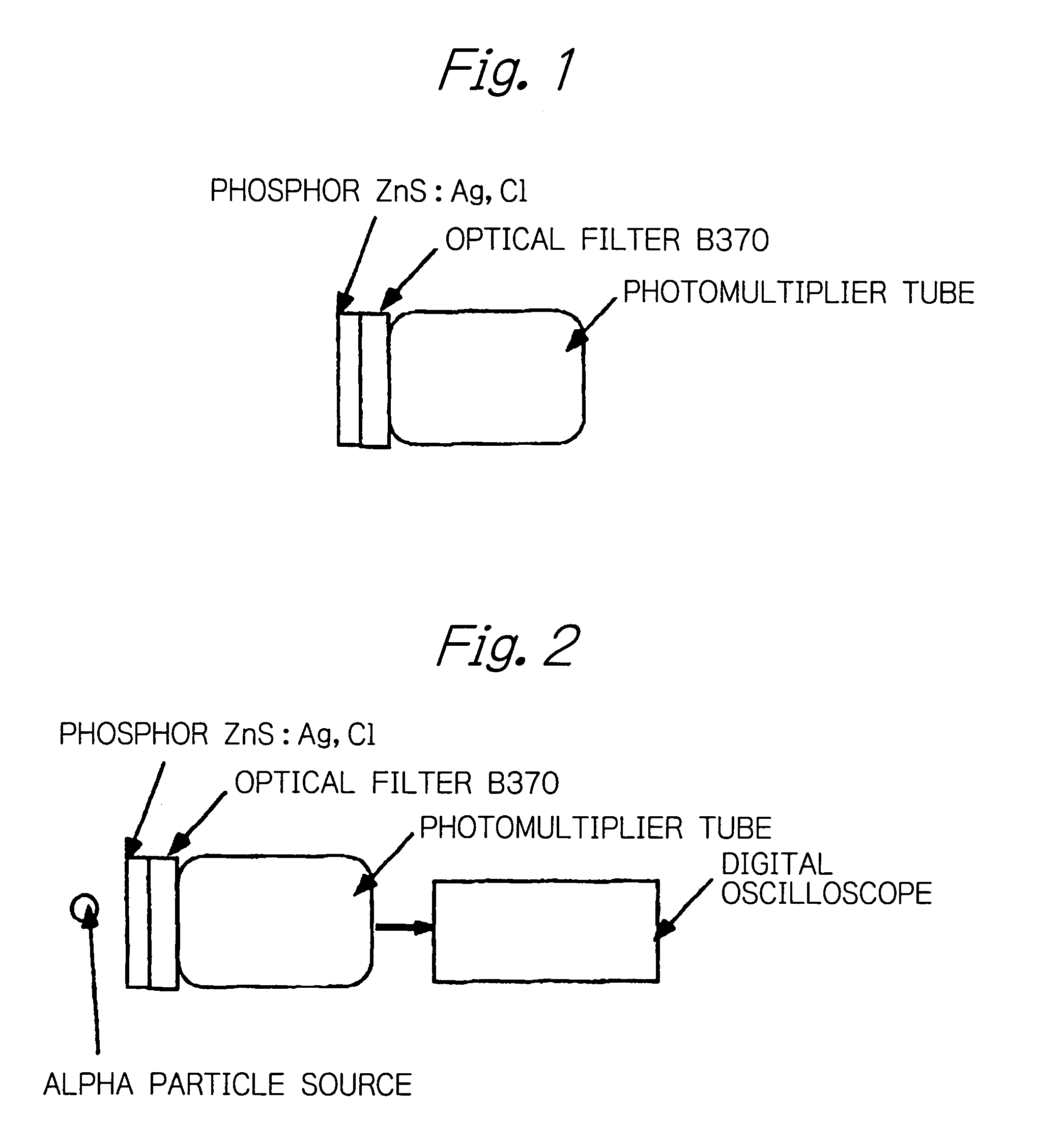Particle detector and neutron detector that use zinc sulfide phosphors
a technology of zinc sulfide phosphor and neutron detector, which is applied in the direction of radiation intensity measurement, instruments, x/gamma/cosmic radiation measurement, etc., can solve the problems of difficult to measure accurate counting rates, and achieve easy detection, high fluorescence yield, and improved counting characteristics
- Summary
- Abstract
- Description
- Claims
- Application Information
AI Technical Summary
Benefits of technology
Problems solved by technology
Method used
Image
Examples
example 1
[0020]In this example, a particle detector using the phosphor ZnS:Ag,Cl as a particle detecting element is described with reference to FIG. 1.
[0021]The particle detector shown in FIG. 1 comprises ZnS:Ag,Cl as the particle detecting element coupled to the optical filter B370 which passes wavelengths shorter than about 450 nm and which in turn is coupled to a photomultiplier tube.
[0022]The wavelength dependency of the life (decay time) of fluorescence from ZnS:Ag,Cl was measured with a circuit shown in FIG. 2. The particle source was Am-241 emitting alpha particles of 5.4 MeV. The phosphor ZnS:Ag,Cl was mixed with an organic adhesive and applied to a glass plate in an amount of 5 mg / cm2. Thereafter, the fluorescence emitted from ZnS:Ag,Cl was selectively passed through various optical filters having different transmission wavelength ranges and detected with a photomultiplier tube (R647P of HAMAMATSU PHOTONICS K.K.) The waveforms of output signals were measured with a digital oscillosc...
example 2
[0025]In this example, a neutron detector is described with reference to FIG. 4. A mixture of the phosphor ZnS:Ag,Cl with the neutron converter 6LiF was used as a neutron detecting scintillator and the short decay time of the short-wavelength component of fluorescence from the scintillator was utilized to improve the counting characteristics of the detector.
[0026]The neutron detector shown in FIG. 4 comprises the mixture of the phosphor ZnS:Ag,Cl with the neutron converter 6LiF as a neutron detecting scintillator which is coupled to the optical filter B370 which passes wavelengths shorter than about 450 nm and which in turn is coupled to a photomultiplier tube (R647P of HAMAMATSU PHOTONICS K.K.)
[0027]The wavelength dependency of the life of fluorescence from ZnS:Ag,Cl was measured with a circuit shown in FIG. 2. The neutron detecting scintillator was prepared by mixing 60 mg / cm2 of ZnS:Ag,Cl and 15 mg / cm2 of the neutron converter 6LiF with an organic adhesive and applying the mixtur...
example 3
[0028]In this example, a particle detector that uses the phosphor ZnS:Ag,Cl as a particle detecting element and which can detect particles as distinguished from gamma rays is described with reference to FIG. 6.
[0029]The particle detector shown in FIG. 6 is capable of detecting particles as distinguished from gamma rays and it comprises ZnS:Ag,Cl as a particle detecting element coupled to FV026 as an optical filter that passes wavelengths shorter than about 420 nm and which in turn is coupled to a photomultiplier tube.
[0030]An experiment was made to confirm that the wavelength spectrum of fluorescence from ZnS:Ag,Cl changed between the cases of inputting alpha particles and gamma rays. The incident alpha particles were those of 5.4 MeV emitted from Am-241 and the incident gamma rays were those of 60 keV which were also emitted from Am-241 but which were made free from the effects of alpha particles by means of a thin sheet put on the surface of the source Am-241. The results of the e...
PUM
| Property | Measurement | Unit |
|---|---|---|
| wavelengths | aaaaa | aaaaa |
| wavelengths | aaaaa | aaaaa |
| wavelengths | aaaaa | aaaaa |
Abstract
Description
Claims
Application Information
 Login to View More
Login to View More - R&D
- Intellectual Property
- Life Sciences
- Materials
- Tech Scout
- Unparalleled Data Quality
- Higher Quality Content
- 60% Fewer Hallucinations
Browse by: Latest US Patents, China's latest patents, Technical Efficacy Thesaurus, Application Domain, Technology Topic, Popular Technical Reports.
© 2025 PatSnap. All rights reserved.Legal|Privacy policy|Modern Slavery Act Transparency Statement|Sitemap|About US| Contact US: help@patsnap.com



